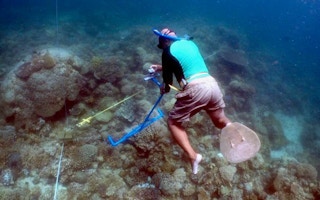A new marine protected area (MPA) has been founded in the Philippines within what are considered some of the most biologically diverse waters on Earth.
The new MPA, which has been given the name Pirasan, was declared by the municipality of Tingloy on Maricaban Island in the Philippines’ Batangas Province. Pirasan encompasses more than 54 acres (about 22 hectares) of thriving coral reef habitat. The MPA was designed to protect this pristine reef system and, at the same time, boost an emerging local ecotourism industry.
The island of Maricaban is located in the Verde Island Passage, a region that harbours considerable marine biodiversity. The reef ecosystem in the new MPA is considered to be healthy and resilient, but it is facing threats from local pollution, sedimentation, coastal development, and global climate change.
The Tingloy government and local community enthusiastically established the MPA together with collaborating institutions including the U.S.’s California Academy of Sciences, the Philippines’ De La Salle University-Manila, and two local non-profits: Pusod Inc. and the SEA Institute – VIP.
“
Artificial reefs will never be as diverse and healthy as natural reefs, so it’s always better to protect the reefs you have than to try to play Humpty Dumpty with a damaged or destroyed reef.
Terry Gosliner, senior curator for invertebrate zoology, California Academy of Science
According to Meg Burke, Director of Science Integration and Operations for the California Academy of Sciences, a combination of factors made protecting the area included in the new MPA a priority. “It was a relatively pristine reef; it was part of a monitoring project; and the Tingloy municipal government was eager to take a strong environmental stance,” Burke told Mongabay.
“As an intact, healthy coral reef ecosystem, there is a tremendous diversity of wildlife within the MPA boundaries including hard corals, soft corals, crinoids (feather stars), nudibranchs, giant clams, all sorts of fish.” Pirasan also includes sandy beach habitats where sea turtles and a variety of other fish species can be found.
In a statement, Burke added that “Tingloy is a community like so many in the Philippines, and elsewhere in the tropical world, that is trying to figure out how to feed their families in the face of climate change and diminishing resources.”
“It is not always easy to recognise that the short-term sacrifice of establishing a marine protected area, which limits fishing activity and may mean your family has less to eat today or tomorrow, is worth it for the long-term gain of nurturing healthy reef ecosystems. Pirasan is a symbolic step toward recognizing greater future yields, more livelihood opportunities, and a brighter future.”
In addition to establishing the new protected area, the municipality of Tingloy has committed to a uniquely ambitious two-year program to monitor the reef’s health and empower local residents as stewards of the reef. Routine surveys of marine species that are important indicators of reef health will be conducted alongside regular monitoring of the shoreline to keep it free of trash.
These community-led efforts will be factored into a “reef health report card” along with additional data collected by program scientists in order to establish baseline data on the ecosystem and allow for the effectiveness of the MPA to be measured over time.
“Monitoring helps the local community and the scientific community know when significant changes occur, and if necessary intervention or management plans can be enacted more quickly,” Burke told Mongabay. “For example, monitoring over the last month revealed that there was a significant increase in the coral-eating Crown-of-Thorns Starfish and there had been an increase in dead coral. Because there was monitoring, we knew about the [Crown-of-Thorns Starfish] outbreak sooner, and several teams of snorkelers and divers undertook a removal campaign last weekend, removing over 400 [Crown-of-Thorns Starfish] from the reef.”
Many local communities around the world monitor their MPAs to make sure poaching and other disturbances are not going occurring, Burke said, but most municipal MPAs in the Philippines do not have any type of formal monitoring that combines the efforts of local community members and scientists. The hope is that the Pirasan’s monitoring program will set an example for other MPAs in the country. “The long-term goal of the monitoring project is to share this model across the Philippines,” Burke said.
“The establishment of this new MPA — and its long-term monitoring — is significant because it recognises the need to set aside areas for conservation before the reef is lost or damaged beyond its ability to come back,” Terry Gosliner, California Academy of Science’s Senior Curator of Invertebrate Zoology, said in a statement.
“Artificial reefs will never be as diverse and healthy as natural reefs, so it’s always better to protect the reefs you have than to try to play Humpty Dumpty with a damaged or destroyed reef.”
This story was published with permission from Mongabay.com










